


xxxxxThe Dutch
post-impressionist painter Vincent Van Gogh, after a number
of failed careers, started painting in earnest on returning to his
parents, then living in Nuenen, Brabant, in 1884. His early works
were sombre in colour and mood, doubtless influenced by his time
spent as a teacher in London, and a lay preacher in the poor
mining district of Borinage in southern Belgium. Typical of this
period was his Potato Eaters. In March
1886, however, he moved to Paris, living with his younger brother
Theo. There he met a number of the leading Impressionists -
including Toulouse Lautrec, Camille Pissarro, Paul Gauguin and
George Seurat -
and he soon adopted their bright, pure
colours and - in part - their distinctive brushwork. He
produced 200 works during his two-year stay in Paris,
portraits (such as “Père” Tanguy), still-lifes
(such as Vase of Gladioli), and numerous
scenes of the city, including Boulevard de
Clichy, and Banks of the Seine with
Boats. In 1888
he settled in Arles in the South of France, and there he delighted
in the sunshine, the warm colours and the quality of the light. To
this period belongs his famous Vase of Twelve
Sunflowers, Bedroom at Arles
and Café Terrace at Night. It was then
that he began to use thick layers of paint in contrasting colours
to give his subject meaning and vitality. In the October, however,
at his invitation, his friend Paul Gauguin joined him, and the
result was disastrous. After two months of bitter quarrelling, Van
Gogh threatened Gauguin with a razor and then turned the blade on
himself, cutting off part of his left ear. As a result he spent a
year in a sanatorium in Saint-Rémy where his work - such
as his Starry Night and Wheatfield
with Cypresses - were notable for their swirling
brushwork, a symptom of his troubled mind. He spent his last days
at Auvers just north of Paris. It was there in July 1890 that he
shot himself and died of his wound. Van Gogh, along with the likes
of Gauguin and Cézanne, greatly influenced Expressionism. As we
shall see, the Norwegian artist Edvard Munch (1863-1944) was
related to this movement, with its powerful emotion and stark
contrasts in colour.
VINCENT VAN GOGH 1853 -
1890 (Va, Vb, Vc)
Acknowledgements
Van Gogh: Self-Portrait
– Musée d’Orsay, Paris; The Potato Eaters – Rijksmuseum Vincent
van Gogh, Amsterdam; Flowering Plumtree – Rijksmuseum Vincent van
Gogh, Amsterdam; Bridges at Asnières – E.G. Bührle Collection,
Zurich; Père Tanguy – private collection; Wheatfield with Crows –
Rijksmuseum Vincent Van Gogh, Amsterdam; Starry Night – Museum of
Modern Art, New York; Bedroom at Arles – Musée d’Orsay, Paris;
Sunflowers – National Gallery, London; Café at Arles at night –
Rijksmuseum Kroller-Muller Museum, Otterlo, Netherlands;
Wheatfield with Cypresses – National Gallery, London; Portrait of
Theo – Rijksmuseum Vincent Van Gogh, Amsterdam.
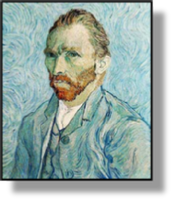 xxxxxThe Dutch painter Vincent Van Gogh, little known or
appreciated during his brief lifetime, today ranks as one of the
most original artists of all time. His 800 paintings and well over
1,000 drawings included an abundance of landscapes, numerous
portraits, and a number of still-lifes, many noted for their
bold, contrasting colours and their powerful rhythmic design. For
the most part, the paintings which eventually brought him fame
were produced during the last two years of his life, when he was
living at Arles amid the warmth, luminous light and vibrant
colours of the South of France. The
self-portrait here was painted just a few months before he
took his own life in July 1890. His haggard features and the
swirling background capture the troubled state of his mind.
xxxxxThe Dutch painter Vincent Van Gogh, little known or
appreciated during his brief lifetime, today ranks as one of the
most original artists of all time. His 800 paintings and well over
1,000 drawings included an abundance of landscapes, numerous
portraits, and a number of still-lifes, many noted for their
bold, contrasting colours and their powerful rhythmic design. For
the most part, the paintings which eventually brought him fame
were produced during the last two years of his life, when he was
living at Arles amid the warmth, luminous light and vibrant
colours of the South of France. The
self-portrait here was painted just a few months before he
took his own life in July 1890. His haggard features and the
swirling background capture the troubled state of his mind.
xxxxxHe was born
in the small Dutch village of Groot-Zundert in North Brabant,
the son of a Protestant pastor. He showed an interest in art from
his early teens, but he was moody and restless by temperament and
found it difficult to settle upon a chosen career. After attending
a boarding school at Zevenbergen, he spent four years working for
a firm of art dealers in The Hague, including a spell in the
company’s offices in Paris and London. While in London, however,
he became infatuated with his landlady’s daughter, his work
suffered as a consequence, and he lost his job. He then tried his
hand at teaching, first in Ramsgate and then in London. It was
there that, moved by the poverty he encountered, he changed
direction again, and decided to enter the Church. His desire to
assist those in need was genuine, but he did not have the staying
power to master his theological studies at Amsterdam University,
and he was forced to quit the course after a year. Undeterred he
went to work for two years as a lay preacher in the Borinage, a
poor mining district in southern Belgium. There he lived a hand to
mouth existence in helping the poor and needy, but once again, he
was not considered suitable for his chosen task. It was then, at
the age of 27, having visited art galleries during his earlier
travels - notably those in Paris and London -, that he
decided to return home and become a painter. It was to prove a
short career marred by poverty, alcoholism and, eventually, a
sudden plunge into insanity. Only the world of art was to reap the
benefit.
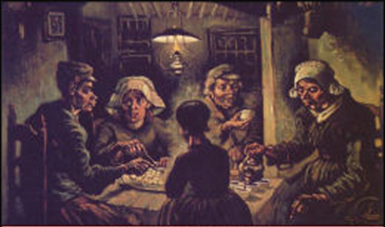 xxxxxSupported financially by his younger brother Theo, he
started his new career by sketching outdoors and visiting art
galleries. He took drawing lessons in Brussels, received some
instruction from his cousin Anton Mauve in The Hague, and in 1884
rejoined his parents, then living at Nuenen, north Brabant. It was
there that he began painting in earnest and developing his own,
unique style. His early paintings - doubtless influenced by
his stay in London and Borinage - were sombre and somewhat
crude in character, the majority depicting the arduous life of the
local peasants. To this period belongs his most ambitious work The Potato Eaters (here illustrated),
a gloomy study of a peasant family sitting down to their
evening meal. Notable among other paintings of this time are Old Tower of Nuenen with People Walking,
Weaver Standing in Front of a Loom, Avenue of Poplars at Sunset, Two
Rats, and Head of Peasant Woman with
White Cap.
xxxxxSupported financially by his younger brother Theo, he
started his new career by sketching outdoors and visiting art
galleries. He took drawing lessons in Brussels, received some
instruction from his cousin Anton Mauve in The Hague, and in 1884
rejoined his parents, then living at Nuenen, north Brabant. It was
there that he began painting in earnest and developing his own,
unique style. His early paintings - doubtless influenced by
his stay in London and Borinage - were sombre and somewhat
crude in character, the majority depicting the arduous life of the
local peasants. To this period belongs his most ambitious work The Potato Eaters (here illustrated),
a gloomy study of a peasant family sitting down to their
evening meal. Notable among other paintings of this time are Old Tower of Nuenen with People Walking,
Weaver Standing in Front of a Loom, Avenue of Poplars at Sunset, Two
Rats, and Head of Peasant Woman with
White Cap.
xxxxxIn 1885 his
father died, and Van Gogh was soon on the move again. He left
Holland - never to return - and enrolled at the Academy
in Antwerp. His stay was short-lived. He took a dislike to
the academic training, failed the course at the end of his first
term, and decided to move to Paris before he was officially
dismissed. It was a move, taken in March 1886, that was to bring
about a fundamental change in his concept of art and his future as
an artist.
xxxxxFor the
next two years Van Gogh shared a flat with his brother Theo in the
Paris suburb of Monmartre. Theo was an art dealer, and through him
he met and painted with the leading Impressionists -
including Toulouse Lautrec, Camille Pissarro, Paul Gauguin and the
pointillists Georges Seurat and Paul Signac - and he was
completely won over by their technique. It is hardly surprising;
Impressionism suited his purpose. He liked to work fast and out of
doors, and its use of pure, bright colours, applied straight onto
the canvas, owed nothing to traditional art and the restrictions
it imposed. As a result, he renounced the sombre colours and the
dull subject matter of his early years; changed to a brighter
palette; developed a much freer style of brushwork, and chose
topics of a lighter vein. And while in Paris he also came to
admire, like the Impressionists themselves, the decorative colours
and firm, simple outlines of Japanese art, then seen at its best
in the works of the printmakers Ando Hiroshige and Katsushika Hokusai. But whilst he
embraced in part these new, avant-garde movements, Van Gogh
also valued the works of artists such as Eugène Delacroix, Jean
François Millet and members of the Barbizon School.
Vc-1881-1901-Vc-1881-1901-Vc-1881-1901-Vc-1881-1901-Vc-1881-1901-Vc-1881-1901-Vc
xxxxxTo this
period belongs a large number of portraits (many of himself),
still lifes, and scenes of Paris, some 200 in all. They included Flowers in a Blue Vase and Vase
of Gladioli, The Kingfisher, A Pair of Shoes (early 1887),
Boulevard de Clichy, and Banks of the
Seine with Boats. Illustrated above (left to right) are Flowering Plumtree, clearly showing the
Japanese influence, Bridges across the Seine
at Asnière, owing much to impressionism, and the portrait
of Julien “Père” Tanguy. He ran a paint
shop in the city, together with a small gallery, and it was there
that the lmpressionists were able to exhibit their works.
xxxxxVan Gogh’s
two years in Paris played a pivotal role in the development of his
artistic career, but they were not without their personal
troubles. Towards the end of 1887, the long hours he had spent in
painting, and his heavy drinking began to take their toll on his
health. This, together with a growing hostility towards him -
caused by his quick temper and a stubborn belief in his own ideas
- signalled the need for change. At the beginning of 1888
he decided to “take myself off somewhere down south”. In February
he arrived at Arles, a provincial city near Marseilles, ready to
make a new start. It was to prove the last phase in his hectic,
troubled life.
xxxxxAt first,
his move to the South of France with its sunshine, warm colours
and quality of light filled him with hope. He rented an attractive
Yellow House - the colour of friendship as he saw it -
and embarked on the happiest time of his life. He had reached, he
informed his brother, the “kingdom of light”, and ideas were
coming to him “in swarms”. One of these ideas was the setting up
of an artists’ colony, and the first step towards that was to
invite his friend Paul Gauguin to join him. As we shall see (1888), Gauguin, then
working in Brittany, was somewhat wary of the idea. He did not
hold Van Gogh in high regard, either as a person or as a painter,
but persuaded by Theo, he eventually arrived in the October, the
sunshine of Province playing a part in his decision. The result
was disastrous. The arrogant, cynical Gauguin and the obstinate,
fiery Van Gogh were soon quarrelling violently. The climax came in
December when Van Gogh, losing all self-control, threatened
Gauguin with an open razor. Gauguin fled the house and left for
Paris by the first available train. In the meantime Van Gogh used
the razor upon himself, cutting off part of his left ear. His
idyllic dream had ended in a nightmare. From now until his death
he was to struggle with recurring bouts of deep depression,
sometimes bordering on dementia.
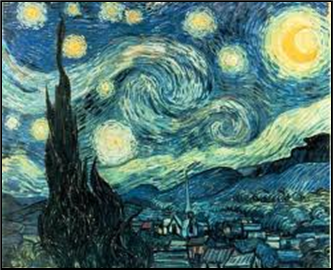 xxxxxEarly in 1889, acutely aware of his dangerous mental
state and the fear and hostility of his neighbours, he entered the
sanatorium at the nearby town of Saint-Rémy as a voluntary
patient. There, slowly coming to terms with his unstable
condition, he produced some 200 canvases in the space of a year.
Among these works - products of a tortured mined - were
his Starry Night (illustrated
here), his Olive Trees,
and a series of paintings depicting cypress trees in twisted, flame-like
shapes, seen in his Wheatfield with Cypresses.
(illustrated below). These “Egyptian obelisks in green”, he wrote at
the time, “are always occupying my thoughts”.
xxxxxEarly in 1889, acutely aware of his dangerous mental
state and the fear and hostility of his neighbours, he entered the
sanatorium at the nearby town of Saint-Rémy as a voluntary
patient. There, slowly coming to terms with his unstable
condition, he produced some 200 canvases in the space of a year.
Among these works - products of a tortured mined - were
his Starry Night (illustrated
here), his Olive Trees,
and a series of paintings depicting cypress trees in twisted, flame-like
shapes, seen in his Wheatfield with Cypresses.
(illustrated below). These “Egyptian obelisks in green”, he wrote at
the time, “are always occupying my thoughts”.
xxxxxIn May the
following year, on the advice of his old friend Camille Pissarro,
he left the sanatorium and moved to the artist colony at Auvers-sur-Oise,
a village a little northwest of Paris. At first he seemed
contented, but his paintings told a different story. His Church
at Auvers was distorted in shape, harsh in colour, and
painted from a strange angle, and his Self
Portrait of this time, as already noted, showed a
troubled mind. Towards the end of July, soon after completing his
Field under Thunderclouds and his Crows in the Wheatfields he took his own
life. Beset with money troubles and once more disturbed mentally,
he walked out into the surrounding fields, shot himself in the
chest, and then staggered back to his little room above a café.
Two days later he died in his brother’s arms, aged 37.
xxxxxIt was
during his two years at Arles, a stay which had begun with such
promise and ended in such tragedy, that Van Gogh painted his best
known works. This was his most creative period. Beneath his
“golden sun” of Provence he produced a wealth of portraits,
landscapes and still-lifes, many of which have remained
highly popular to this day. Working sixteen hours or more a day,
he began to express himself “forcibly” through the application of
thick layers of pure, intense pigment, often in contrasting
colours - red and green, blue and orange. He saw colour as
giving his subject meaning and vitality, as in the yellow glow and
dark blue sky in his Café Terrace at Night,
or the myriad of yellow tones that made up his famous Vase
with Twelve Sunflowers of 1888
(both illustrated below). And at the same time he moved away from the basic
technique of Impressionism, using his powerful swirling brush
strokes - stirred by his own emotions - to bring immediate
life to a tree, field, cloud or mountain. He interpreted the natural
world around him in his own way, and this was at the root of his
unique style.
xxxxxLeft to
Right: Bedroom at Arles, a work noted
for its harmonious colours and strong outlines; Vase
of Fourteen Sunflowers (The version with twelve flowers
was auctioned in 1987 for $40 million), and his Café
Terrace at Night, (today the Café Van Gogh), one of his
best known works, notable for its contrasting colours and
brilliant design. Other works from his days at Arles include Fishing Boats on the Beach at Saintes-Maries,
Painter on his way to Work, the portrait
of postman Joseph Roulin, Encampment
of Gypsies with Caravans, Vincent’s
Chair with His Pipe, The Harvest,
and a series of Orchards in Blossom. The Bridge at Langlois with Women Washing is
a particularly fine example of his restricted palette. Only six
basic colours were used to capture this busy scene.
xxxxxWhilst at
Saint-Rémy he produced some 200 works, including a series of
Olive Trees and Olive
Picking, his Wheatfield with
Cypresses (illustrated
below) and four portraits of L’Arlesienne
(Madame Ginoux). Notable among his paintings at Auvers were
various studies of the village itself, Thatched
Cottages at Cordeville, and two portraits of Doctor
Gachet, the second of which was sold for more than $82
million when auctioned in May 1990. His
Wheatfield with Crows (also illustrated
below), painted in the same month that he committed suicide, is seen
by some as a turbulent, foreboding work anticipating his coming
death.
xxxxxVanxGogh, together
with the likes of the French artists Paul Gauguin and Paul
Cézanne, are often referred to as Post
Impressionists. Coming after the decline
of Impressionism, they accepted and extended the movement’s bold
use of pure colour, but rejected its loss of structure and its
lack of emotional involvement. The vivid colours and the inner
emotions expressed in their works had an immense influence on the
development of modern art, particularly upon French Fauvism, led by Henri
Matisse, André Derain and Maurice de Vlaminck, and German Expressionism, demonstrated
amongst others by the Russian painter Wassily Kandinsky. As we
shall see, the Norwegian artist Edvard Munch (1863-1944) was
related to this movement, with its stark contrasts in colour and
its powerful, naked emotion.
xxxxxIncidentally, Van Gogh only sold one canvas throughout his
lifetime. In February 1890, just a few months before his death, a
painting of a vineyard in Arles was sold in a Brussels exhibition
for 400 francs. “I cannot help it,” he once wrote, “if my
paintings do not sell. The time will come when people will see
that they are worth more than the price of the paint”. How right
he was! ……
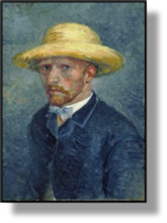
xxxxx……xThroughoutxhis
troubled life Van Gogh owed a great deal to the constant support
and encouragement given to him by his devoted younger brother Theo. He gave him a home
during his two years in Paris, sent him money on a regular basis,
and paid for his art supplies in Arles and Saint-Rémy. When
Vincent took his own life he was grief-stricken, and six
months later - due perhaps to the strain he was under -
he died of a stroke, leaving a wife and a baby son. (This portrait
is by his brother Vincent) ……
xxxxx……xA valuable outcome of this
close relationship between the two brothers was the 700 or so
letters sent by Vincent to Theo throughout his artistic career.
This collection of letters throws a fascinating and illuminating
light not only upon his work - his ideas and changes in
technique - but also upon his own hopes and fears in a
troubled, frenzied existence.
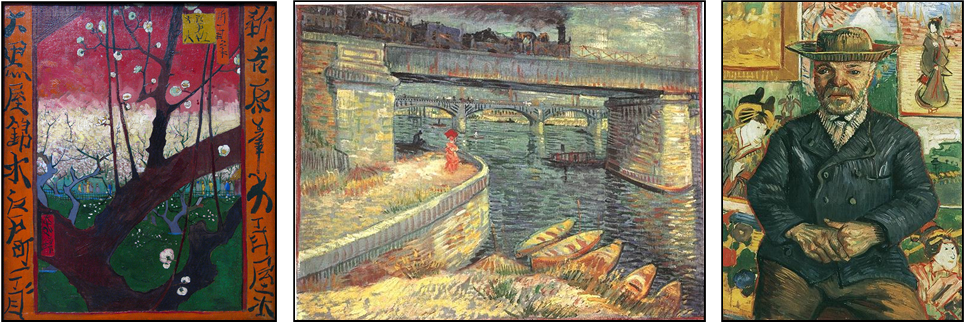
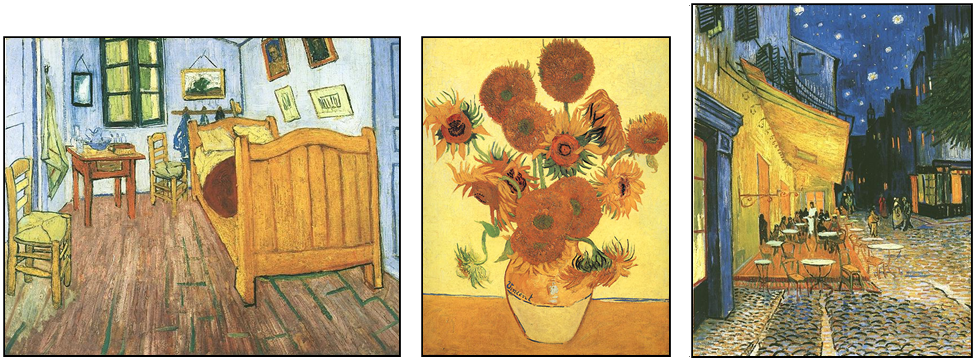







 xxxxxThe Dutch painter Vincent Van Gogh, little known or
appreciated during his brief lifetime, today ranks as one of the
most original artists of all time. His 800 paintings and well over
1,000 drawings included an abundance of landscapes, numerous
portraits, and a number of still-
xxxxxThe Dutch painter Vincent Van Gogh, little known or
appreciated during his brief lifetime, today ranks as one of the
most original artists of all time. His 800 paintings and well over
1,000 drawings included an abundance of landscapes, numerous
portraits, and a number of still- xxxxxSupported financially by his younger brother Theo, he
started his new career by sketching outdoors and visiting art
galleries. He took drawing lessons in Brussels, received some
instruction from his cousin Anton Mauve in The Hague, and in 1884
rejoined his parents, then living at Nuenen, north Brabant. It was
there that he began painting in earnest and developing his own,
unique style. His early paintings -
xxxxxSupported financially by his younger brother Theo, he
started his new career by sketching outdoors and visiting art
galleries. He took drawing lessons in Brussels, received some
instruction from his cousin Anton Mauve in The Hague, and in 1884
rejoined his parents, then living at Nuenen, north Brabant. It was
there that he began painting in earnest and developing his own,
unique style. His early paintings - xxxxxEarly in 1889, acutely aware of his dangerous mental
state and the fear and hostility of his neighbours, he entered the
sanatorium at the nearby town of Saint-
xxxxxEarly in 1889, acutely aware of his dangerous mental
state and the fear and hostility of his neighbours, he entered the
sanatorium at the nearby town of Saint-





